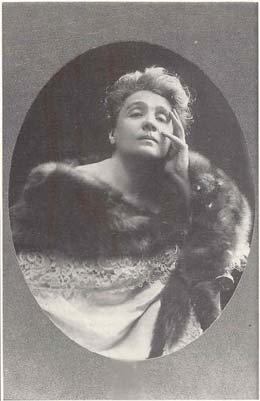1. ELEONORA DUSE (1858-1924). Ed. Giorgio Sternfeld, Venezia. C.1901.
2. ELEONORA DUSE. Grus Auss... Collection Das Grosse Jahrundert. C.1899.
3. E.DUSE em Francesca da Rimini, de D'Annunzio. Fot.Sciutto, 1901.
4. ELEONORA DUSE. Fot.C.1906.
5. ELEONORA DUSE. Fot.C. 1901.
6. DRAMMATICA. C.p. "fantasia" em homenagem a Arte Dramatica, com o retrato da atriz e de outras personalidades do Teatro europeu.
7. ELEONORA DUSE em Francesca da Rimini, de D'Annunzio. Fot.Sciuto, 1901.
8. DUSE. C.p. " fantasia" com tres retratos da atriz.
9. ELEONORA DUSE em Citta Morta, de D'Annunzio. Fot.Sciutto, 1901.
10. ELEONORA DUSE em Citta Morta, de D'Annunzio. Fot. Sciutto, 1901.
11. LA DUSE. Fot. A .Dupont, New York.
12. ELEONORA DUSE. Fot.Rizzo, São Paulo, 1907.

4
ELEONORA DUSE
Considerada
a maior atriz dramática italiana de seu tempo e a primeira grande
atriz moderna, Eleonora Duse celebrizou-se com um estilo pessoal de representação,
influenciando os novos rumos da própria arte que a imortalizou.
Nascida
em Vigevano, na Lombardia, em 1858, predestinada a grandes romances, Duse
viveu com vigorosa maestria Casa de Bonecas, A Dama do Mar e Hedda Gabler,
e Ibsen, além de obras de Sardou, Dumas Filho e outros escritores
da época. Sonho de uma Manha de Primavera (1897) La Gioconda (1899)
e Francesca da Rimini (1901) de Gabriele D'Annunzio, escritas com as tintas
da paixão pelo jovem poeta italiano especialmente para ela, expressam
o fascínio e a inspiração despertados pelo grande
amor que os atraiu.
Recebendo
na imprensa carioca fervorosos elogios de Arthur Azevedo, Eleonora Duse
apresentou-se no Brasil entre 15 de junho e 16 de setembro de 1885, no
Imperial Teatro São Pedro de Alcantara. Retornou em 1907, ocupando
o Teatro Lirico do Rio de Janeiro e o Teatro Santana de São Paulo
entre 19 de junho e 16 de julho.
O rompimento com D' Annunzio
após uma longa e tumultuada ligação amorosa, levou
Eleonora Duse a abandonar os palcos em 1909, aos quais só retornou
em 1921. Tuberculosa, Duse conviveu durante toda a vida com as crises
de hemoptises da doença - como Marguerite Gautier, uma de suas
maiores interpretações. Sua morte em 1924, interrompeu inesperadamente
uma tournée nos Estados Unidos. Conduzida em mortalha ao seu adorado
país de origem, recebeu do Governo italiano funerais de Estado.
ELEONORA DUSE
Considered
to be the highest standing Italian dramatic artists of her time and the
first great modern actress Eleonora Duse became famous through a personal
style of acting that influenced the new courses of the very art that rendered
her immortal.
Born in Vigevano, Lombardy,
in 1858, and fated to great romances, Duses played, with powerful mastery.
A Doll' s House, The Lady From the Sea and Hedda Gabler by Ibsen, besides
the works by Sardou, Dumas son and other writers of the Time. Dream of
a Spring Morning (1897) La Gioconda (1899) and Francesca da Rimini (1901)
by Gabrielle D' Annunzio, written with the colours of passion especially
for her, express the fascination and inspiration awakened by the love
that brought them together.
Having received fervent
praises from Arthur Azevedo in the press of Rio, Eleonora Duse played
in Brasil between June 15 and September 16 1885, at the São Pedro
de Alcantara Imperial Theatre. She returned in 1907, performing the the
Liric Theatre of Rio de Janeiro and the Santana de São Paulo Theatre
between June 19 and July 16.
The breaking up
with D' Annunzio after a long and tumultuous love affair, led Eleonora
Duse to withdraw from the stage in 1909, a place to where she only returned
in 1921. Suffering from consumption, Duse was familiar throughout her
life with the disease' s hemoptysical crisis - just as Marguerite Gautier,
one of her most famous interpretations. Her death in 1924, unexpedctedly
interrupted a tour in the United States. Wrapped in a shround, she was
taken back to her beloved country of birh, where she was given a State
funeral by the Italian Government.